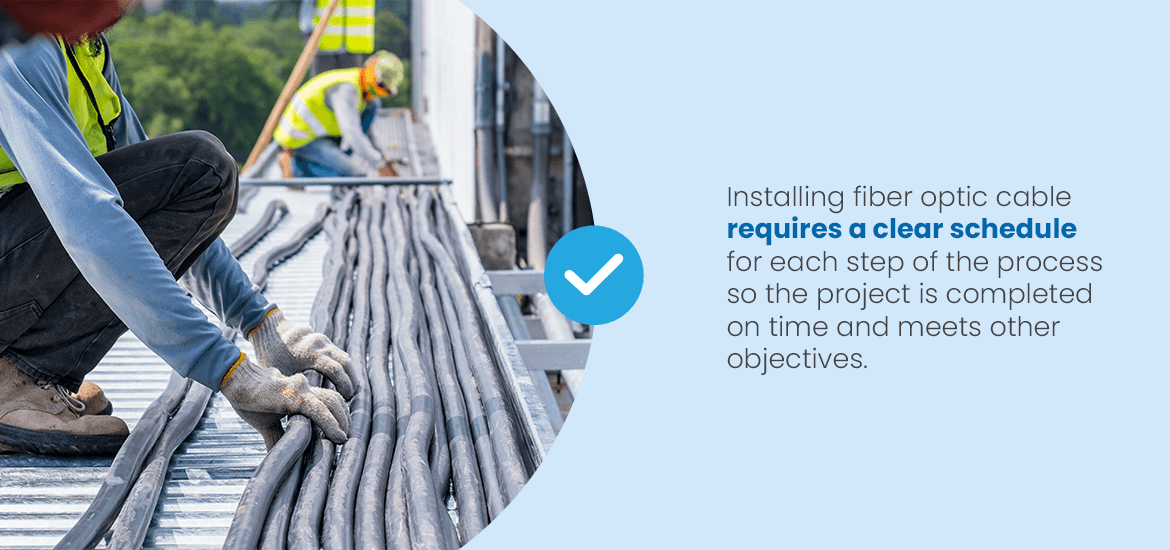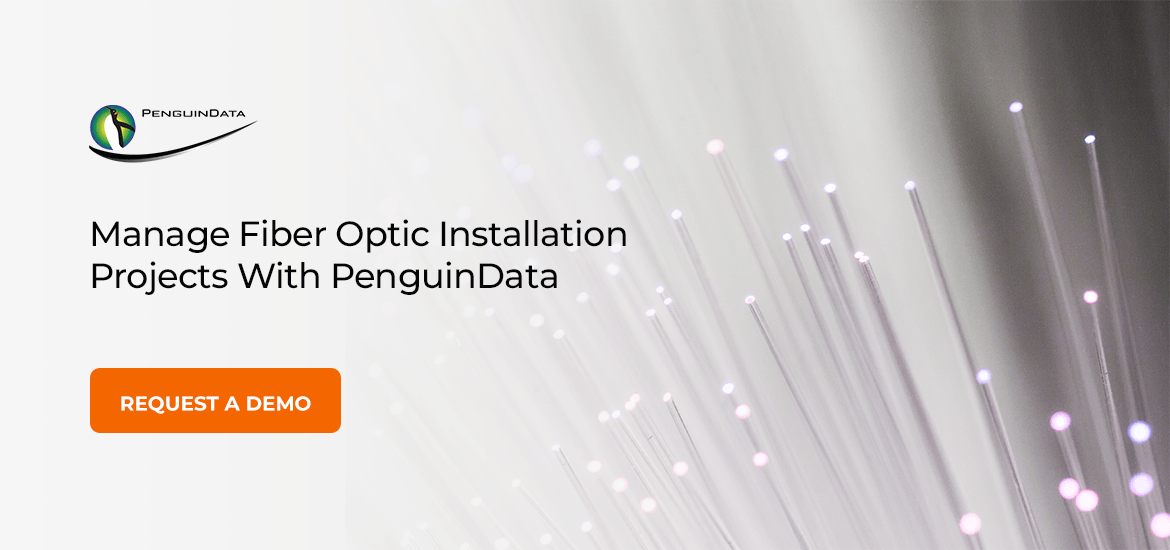
Table of Contents
- Fiber Optic Cable Installation Steps→
- Preparing for Fiber Optic Installation→
- Fiber Optic Planning and Installation Tips→
- PenguinData’s Fiber Optic Construction Solution→
A fast and reliable internet connection is critical for business success in the modern market. Fiber optic cable internet is a popular option for many businesses that want to experience higher upload and download speeds and increased scalability. Your company may see a surge in businesses in your area requesting fiber optic cable installation. Experts predict the multi-mode fiber optic market will reach $910 million by 2025.
Yet the process of installing fiber optic cables can be complicated. Understanding fiber optic cable installation requirements helps your company better serve customers interested in switching to this type of internet. Take a look at these tips for making the fiber optic installation process fast and compliant.
Fiber Optic Cable Installation Process
Whether you are installing municipal fiber networks or fiber optics on business premises, the procedure is similar. Here is the installation process of fiber optic cable:
1. Locate the Optical Network Terminal
Fiber-based internet is delivered to a building through an optical network terminal, also called a fiber jack or fiber network terminal. An optical network terminal is a transceiver positioned on the premises and converts the fiber’s light and optical signals into electrical signals so the building can receive internet.
2. Connect the Fiber Terminal and the Network Box
Once the fiber optic cable installer locates the optical network terminal, they can connect the fiber terminal and the network box. The network box, also called a wall box or termination enclosure, is a large metal box that serves as a demarcation point between the building’s network and that of the internet service provider. The installer may use an Ethernet cable to connect the fiber optic cable to the network box, creating an entry point for the fiber optic cable to enter the building.
3. Connect the Network Box to Power
The network box must receive a constant power supply to provide the building with internet services. The installer may connect the network box to a backup power source, such as a power cable or battery, in case of power loss.
4. Connect Devices to the Network Box
Finally, the fiber optic cable installation crew connects the building’s devices to the network box, either over Wi-Fi or through a wired Ethernet connection. The installer connects devices as soon as possible to ensure the fiber optic cable functions properly.
How to Prepare for Fiber Optic Installation
The importance of construction project management for fiber optic cable installation cannot be overstated. Take these steps when preparing for the fiber optic installation process:
1. Create a Schedule
Installing fiber optic cable requires a clear schedule for each step of the process so the project is completed on time and meets other objectives. Here are a few stages to include in your fiber optic cable installation schedule:
- Select an installation route
- Acquire necessary city permits
- Coordinate with the facility and electrical personnel
- Create a construction plan
- Set a start date and estimate a completion date
- Review construction plans with contractors and installers
- Review safety rules with contractors and installers

2. Order Tools and Materials
With your schedule set, you must order any additional tools and materials for the project. Complete this step as early as possible, as lead times may affect your project start date. You will need stock items such as connectors and splice closures, though you may need to custom order the cables. Schedule material delivery before the start date or at specific points in the installation schedule.
3. Coordinate Labor
Coordinate labor with your crew and any subcontractors or other parties involved in the installation process. Select a project manager to oversee the installation, installers who will work on the project and subcontractors you need for additional services. Ensure a transparent system of communication between your project manager and crew, subcontractors and other stakeholders.
4. Provide Job Training
If necessary, you may need to invest in job training for your construction crew before the start date. Training is essential if some crew members don’t have experience using a specific tool or installing a component. Determine whether you can provide training through a training course, manufacturer instruction or training with other crew members.
5. Coordinate Site Security
Construction site security is critical for the security of your materials. Plan for 24-hour site security if necessary to prevent theft and vandalism. You may also need additional security if you receive materials at the construction site rather than at a secure warehouse during off hours.
Fiber Optic Planning and Installation Tips
When preparations are underway, you can begin your fiber optic cable installation project. Consider a few additional tips that will make planning your project and installing fiber optic cables simpler:
1. Plan Your Route
Before laying any cable, carefully plan the route you plan to take with your installation. You may need to acquire permits or authorizations for some areas of your route, so be as detailed as possible. Ensure the route meets installation requirements and doesn’t expose the cable to unnecessary hazards before confirming it.
2. Protect Cables With Conduit
Cables should be sufficiently protected from sharp edges and supported against hanging freely. Install the cable within a conduit in areas of the route where the cable may be exposed to higher stress or numerous bends. Lubricate cable when installing conduits to reduce the risk of breakage.
3. Avoid Overbending Cables
Each cable has a minimum bend radius, and adhering to that value is critical for reducing the possibility of connection interruption. Design the route and install conduit to include as few bends in the cable as possible. Consider a junction box if the cable would otherwise contain too many bends.
4. Check Regulations
Fiber optic cable installation is subject to numerous regulations on both the local and national levels. For example, the installation must meet fire codes, and conduits may have to adhere to specific fiber optic installation standards. Review the relevant regulations to ensure your installation is compliant.
5. Review Safety Guidelines
Reviewing safety guidelines is essential for your crew’s well-being and your installation project’s success. Fiber optic cable installation projects carry the risk of harm from chemicals and sparks from fusion splicing. Post safety rules on the construction site and review them with your entire crew before the start date.
PenguinData’s Fiber Optic Construction Solution
Project managers have numerous responsibilities to juggle when planning a fiber optic cable installation. Insufficient planning and resource management can easily derail a large-scale construction project. Project management software can help you and your crew stay on top of your project schedule, assign tasks and gain complete project visibility.
The PenguinData Construction Project Management Software is your solution for easier fiber optic cable planning and installation. The software provides complete visibility into every aspect of your project, helping you manage assignments and track materials, equipment and labor hours.
The Construction Project Management Software changes how you view and interact with your construction site. Our mapping solution allows project managers to add markers, paths, annotations and more to their project map, improving visualization by highlighting essential areas and providing map viewers with important information. Map Overlay Technology also lets you overlay multiple maps in the same parent map, with updates available in real time.
PenguinData’s software is web-based, eliminating paper processes and giving you access to critical project details from any device and location. Streamline processes from the construction site back to the office for improved oversight and greater efficiency with our Construction Project Management Software.
Manage Fiber Optic Installation Projects With PenguinData
PenguinData Construction Project Management Software revolutionizes the way you run your construction business. The software lets you easily assign crews to project phases and track materials and labor through each phase. Live work-in-progress reports instantly share this information with your office, giving you the insight to keep a finger on the pulse of your projects in real time so you can keep the project on schedule and on budget. And by integrating the software with your corporate dashboard, you can view reports, track files and manage invoicing.
To see for yourself how PenguinData can help you improve the management of your fiber optic cable installation project, schedule a free demo today.

